1.2: Introduction to Whole Numbers
- Page ID
- 15117
\( \newcommand{\vecs}[1]{\overset { \scriptstyle \rightharpoonup} {\mathbf{#1}} } \)
\( \newcommand{\vecd}[1]{\overset{-\!-\!\rightharpoonup}{\vphantom{a}\smash {#1}}} \)
\( \newcommand{\dsum}{\displaystyle\sum\limits} \)
\( \newcommand{\dint}{\displaystyle\int\limits} \)
\( \newcommand{\dlim}{\displaystyle\lim\limits} \)
\( \newcommand{\id}{\mathrm{id}}\) \( \newcommand{\Span}{\mathrm{span}}\)
( \newcommand{\kernel}{\mathrm{null}\,}\) \( \newcommand{\range}{\mathrm{range}\,}\)
\( \newcommand{\RealPart}{\mathrm{Re}}\) \( \newcommand{\ImaginaryPart}{\mathrm{Im}}\)
\( \newcommand{\Argument}{\mathrm{Arg}}\) \( \newcommand{\norm}[1]{\| #1 \|}\)
\( \newcommand{\inner}[2]{\langle #1, #2 \rangle}\)
\( \newcommand{\Span}{\mathrm{span}}\)
\( \newcommand{\id}{\mathrm{id}}\)
\( \newcommand{\Span}{\mathrm{span}}\)
\( \newcommand{\kernel}{\mathrm{null}\,}\)
\( \newcommand{\range}{\mathrm{range}\,}\)
\( \newcommand{\RealPart}{\mathrm{Re}}\)
\( \newcommand{\ImaginaryPart}{\mathrm{Im}}\)
\( \newcommand{\Argument}{\mathrm{Arg}}\)
\( \newcommand{\norm}[1]{\| #1 \|}\)
\( \newcommand{\inner}[2]{\langle #1, #2 \rangle}\)
\( \newcommand{\Span}{\mathrm{span}}\) \( \newcommand{\AA}{\unicode[.8,0]{x212B}}\)
\( \newcommand{\vectorA}[1]{\vec{#1}} % arrow\)
\( \newcommand{\vectorAt}[1]{\vec{\text{#1}}} % arrow\)
\( \newcommand{\vectorB}[1]{\overset { \scriptstyle \rightharpoonup} {\mathbf{#1}} } \)
\( \newcommand{\vectorC}[1]{\textbf{#1}} \)
\( \newcommand{\vectorD}[1]{\overrightarrow{#1}} \)
\( \newcommand{\vectorDt}[1]{\overrightarrow{\text{#1}}} \)
\( \newcommand{\vectE}[1]{\overset{-\!-\!\rightharpoonup}{\vphantom{a}\smash{\mathbf {#1}}}} \)
\( \newcommand{\vecs}[1]{\overset { \scriptstyle \rightharpoonup} {\mathbf{#1}} } \)
\( \newcommand{\vecd}[1]{\overset{-\!-\!\rightharpoonup}{\vphantom{a}\smash {#1}}} \)
\(\newcommand{\avec}{\mathbf a}\) \(\newcommand{\bvec}{\mathbf b}\) \(\newcommand{\cvec}{\mathbf c}\) \(\newcommand{\dvec}{\mathbf d}\) \(\newcommand{\dtil}{\widetilde{\mathbf d}}\) \(\newcommand{\evec}{\mathbf e}\) \(\newcommand{\fvec}{\mathbf f}\) \(\newcommand{\nvec}{\mathbf n}\) \(\newcommand{\pvec}{\mathbf p}\) \(\newcommand{\qvec}{\mathbf q}\) \(\newcommand{\svec}{\mathbf s}\) \(\newcommand{\tvec}{\mathbf t}\) \(\newcommand{\uvec}{\mathbf u}\) \(\newcommand{\vvec}{\mathbf v}\) \(\newcommand{\wvec}{\mathbf w}\) \(\newcommand{\xvec}{\mathbf x}\) \(\newcommand{\yvec}{\mathbf y}\) \(\newcommand{\zvec}{\mathbf z}\) \(\newcommand{\rvec}{\mathbf r}\) \(\newcommand{\mvec}{\mathbf m}\) \(\newcommand{\zerovec}{\mathbf 0}\) \(\newcommand{\onevec}{\mathbf 1}\) \(\newcommand{\real}{\mathbb R}\) \(\newcommand{\twovec}[2]{\left[\begin{array}{r}#1 \\ #2 \end{array}\right]}\) \(\newcommand{\ctwovec}[2]{\left[\begin{array}{c}#1 \\ #2 \end{array}\right]}\) \(\newcommand{\threevec}[3]{\left[\begin{array}{r}#1 \\ #2 \\ #3 \end{array}\right]}\) \(\newcommand{\cthreevec}[3]{\left[\begin{array}{c}#1 \\ #2 \\ #3 \end{array}\right]}\) \(\newcommand{\fourvec}[4]{\left[\begin{array}{r}#1 \\ #2 \\ #3 \\ #4 \end{array}\right]}\) \(\newcommand{\cfourvec}[4]{\left[\begin{array}{c}#1 \\ #2 \\ #3 \\ #4 \end{array}\right]}\) \(\newcommand{\fivevec}[5]{\left[\begin{array}{r}#1 \\ #2 \\ #3 \\ #4 \\ #5 \\ \end{array}\right]}\) \(\newcommand{\cfivevec}[5]{\left[\begin{array}{c}#1 \\ #2 \\ #3 \\ #4 \\ #5 \\ \end{array}\right]}\) \(\newcommand{\mattwo}[4]{\left[\begin{array}{rr}#1 \amp #2 \\ #3 \amp #4 \\ \end{array}\right]}\) \(\newcommand{\laspan}[1]{\text{Span}\{#1\}}\) \(\newcommand{\bcal}{\cal B}\) \(\newcommand{\ccal}{\cal C}\) \(\newcommand{\scal}{\cal S}\) \(\newcommand{\wcal}{\cal W}\) \(\newcommand{\ecal}{\cal E}\) \(\newcommand{\coords}[2]{\left\{#1\right\}_{#2}}\) \(\newcommand{\gray}[1]{\color{gray}{#1}}\) \(\newcommand{\lgray}[1]{\color{lightgray}{#1}}\) \(\newcommand{\rank}{\operatorname{rank}}\) \(\newcommand{\row}{\text{Row}}\) \(\newcommand{\col}{\text{Col}}\) \(\renewcommand{\row}{\text{Row}}\) \(\newcommand{\nul}{\text{Nul}}\) \(\newcommand{\var}{\text{Var}}\) \(\newcommand{\corr}{\text{corr}}\) \(\newcommand{\len}[1]{\left|#1\right|}\) \(\newcommand{\bbar}{\overline{\bvec}}\) \(\newcommand{\bhat}{\widehat{\bvec}}\) \(\newcommand{\bperp}{\bvec^\perp}\) \(\newcommand{\xhat}{\widehat{\xvec}}\) \(\newcommand{\vhat}{\widehat{\vvec}}\) \(\newcommand{\uhat}{\widehat{\uvec}}\) \(\newcommand{\what}{\widehat{\wvec}}\) \(\newcommand{\Sighat}{\widehat{\Sigma}}\) \(\newcommand{\lt}{<}\) \(\newcommand{\gt}{>}\) \(\newcommand{\amp}{&}\) \(\definecolor{fillinmathshade}{gray}{0.9}\)- By the end of this section, you will be able to:
- Use place value with whole numbers
- Identify multiples and and apply divisibility tests
- Find prime factorizations and least common multiples
As we begin our study of elementary algebra, we need to refresh some of our skills and vocabulary. This chapter will focus on whole numbers, integers, fractions, decimals, and real numbers. We will also begin our use of algebraic notation and vocabulary.
Use Place Value with Whole Numbers
The most basic numbers used in algebra are the numbers we use to count objects in our world: \(1, 2, 3, 4\), and so on. These are called the counting numbers. Counting numbers are also called natural numbers. If we add zero to the counting numbers, we get the set of whole numbers.
- Counting Numbers: \(1, 2, 3, …\)
- Whole Numbers: \(0, 1, 2, 3, …\)
The notation “\(…\)” is called ellipsis and means “and so on,” or that the pattern continues endlessly.
We can visualize counting numbers and whole numbers on a number line (see Figure \(\PageIndex{1}\)).

Doing the Manipulative Mathematics activity “Number Line-Part 1” will help you develop a better understanding of the counting numbers and the whole numbers.
Our number system is called a place value system, because the value of a digit depends on its position in a number. Figure \(\PageIndex{2}\) shows the place values. The place values are separated into groups of three, which are called periods. The periods are ones, thousands, millions, billions, trillions, and so on. In a written number, commas separate the periods.
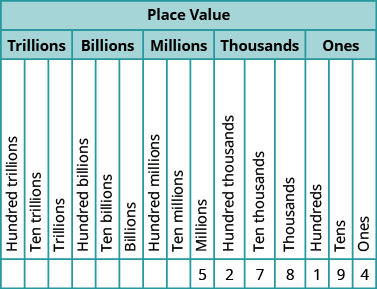
In the number \(63407218\), find the place value of each digit:
- \(7\)
- \(0\)
- \(1\)
- \(6\)
- \(3\)
- Answer
-
Place the number in the place value chart:
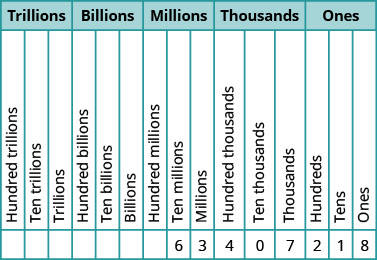
-
- The \(7\) is in the thousands place.
- The \(0\) is in the ten thousands place.
- The \(1\) is in the tens place.
- The \(6\) is in the ten-millions place.
- The \(3\) is in the millions place.
For the number \(27493615\), find the place value of each digit:
- 2
- 1
- 4
- 7
- 5
- Answer
-
- ten millions
- tens
- hundred thousands
- millions
- ones
For the number \(519711641328\), find the place value of each digit:
- 9
- 4
- 2
- 6
- 7
- Answer
-
- billions
- ten thousands
- tens
- hundred thousands
- hundred millions
When you write a check, you write out the number in words as well as in digits. To write a number in words, write the number in each period, followed by the name of the period, without the s at the end. Start at the left, where the periods have the largest value. The ones period is not named. The commas separate the periods, so wherever there is a comma in the number, put a comma between the words (see Figure \(\PageIndex{3}\)). The number \(74218369\) is written as seventy-four million, two hundred eighteen thousand, three hundred sixty-nine.

- Start at the left and name the number in each period, followed by the period name.
- Put commas in the number to separate the periods.
- Do not name the ones period.
Name the number \(8165432098710\) using words.
- Answer
-
Name the number in each period, followed by the period name.

-
Put the commas in to separate the periods.
So, \(8165432098710\) is named as eight trillion, one hundred sixty-five billion, four hundred thirty-two million, ninety-eight thousand, seven hundred ten.
Name the number 9,258,137,904,0619,258,137,904,061 using words.
- Answer
-
nine trillion, two hundred fifty-eight billion, one hundred thirty-seven million, nine hundred four thousand, sixty-one
Name the number 17,864,325,619,00417,864,325,619,004 using words.
- Answer
-
seventeen trillion, eight hundred sixty-four billion, three hundred twenty-five million, six hundred nineteen thousand four
We are now going to reverse the process by writing the digits from the name of the number. To write the number in digits, we first look for the clue words that indicate the periods. It is helpful to draw three blanks for the needed periods and then fill in the blanks with the numbers, separating the periods with commas.
- Identify the words that indicate periods. (Remember, the ones period is never named.)
- Draw three blanks to indicate the number of places needed in each period. Separate the periods by commas.
- Name the number in each period and place the digits in the correct place value position.
Write nine billion, two hundred forty-six million, seventy-three thousand, one hundred eighty-nine as a whole number using digits.
- Answer
-
Identify the words that indicate periods.
Except for the first period, all other periods must have three places. Draw three blanks to indicate the number of places needed in each period. Separate the periods by commas.
Then write the digits in each period. 
The number is 9,246,073,189.
Write the number two billion, four hundred sixty-six million, seven hundred fourteen thousand, fifty-one as a whole number using digits.
- Answer
-
2,466,714,051
Write the number eleven billion, nine hundred twenty-one million, eight hundred thirty thousand, one hundred six as a whole number using digits.
- Answer
-
11,921,830,106
In 2013, the U.S. Census Bureau estimated the population of the state of New York as 19,651,127. We could say the population of New York was approximately 20 million. In many cases, you don’t need the exact value; an approximate number is good enough.
The process of approximating a number is called rounding. Numbers are rounded to a specific place value, depending on how much accuracy is needed. Saying that the population of New York is approximately 20 million means that we rounded to the millions place.
Round 23,658 to the nearest hundred.
- Answer
-




Round to the nearest hundred: 17,852.
- Answer
-
17,900
Round to the nearest hundred: 468,751.
- Answer
-
468,800
- Locate the given place value and mark it with an arrow. All digits to the left of the arrow do not change.
- Underline the digit to the right of the given place value.
- Is this digit greater than or equal to 5?
- Yes–add 11 to the digit in the given place value.
- No–do not change the digit in the given place value.
- Replace all digits to the right of the given place value with zeros.
Round 103,978103,978 to the nearest:
- hundred
- thousand
- ten thousand
- Answer
- 1.
2.Locate the hundreds place in 103,978. 
Underline the digit to the right of the hundreds place. 
Since 7 is greater than or equal to 5, add 1 to the 9. Replace all digits to the right of the hundreds place with zeros. 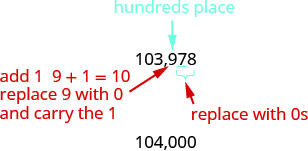
So, 104,000 is 103,978 rounded to the nearest hundred.
3.Locate the thousands place and underline the digit to the right of the thousands place. 
Since 9 is greater than or equal to 5, add 1 to the 3. Replace all digits to the right of the hundreds place with zeros. 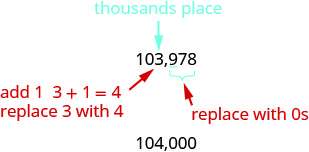
So, 104,000 is 103,978 rounded to the nearest thousand. Locate the ten thousands place and underline the digit to the right of the ten thousands place. 
Since 3 is less than 5, we leave the 0 as is, and then replace the digits to the right with zeros. 
So, 100,000 is 103,978 rounded to the nearest ten thousand.
Round 206,981 to the nearest: 1. hundred 2. thousand 3. ten thousand.
- Answer
-
- 207,000
- 207,000
- 210,000
Round 784,951 to the nearest: 1. hundred 2. thousand 3. ten thousand.
- Answer
-
- 785,000
- 785,000
- 780,000
Identify Multiples and Apply Divisibility Tests
The numbers 2, 4, 6, 8, 10, and 12 are called multiples of 2. A multiple of 2 can be written as the product of a counting number and 2.

Similarly, a multiple of 3 would be the product of a counting number and 3.

We could find the multiples of any number by continuing this process.
Doing the Manipulative Mathematics activity “Multiples” will help you develop a better understanding of multiples.
Table \(\PageIndex{1}\) shows the multiples of 2 through 9 for the first 12 counting numbers.
| Counting Number | 1 | 2 | 3 | 4 | 5 | 6 | 7 | 8 | 9 | 10 | 11 | 12 |
|---|---|---|---|---|---|---|---|---|---|---|---|---|
| Multiples of 2 | 2 | 4 | 6 | 8 | 10 | 12 | 14 | 16 | 18 | 20 | 22 | 24 |
| Multiples of 3 | 3 | 6 | 9 | 12 | 15 | 18 | 21 | 24 | 27 | 30 | 33 | 36 |
| Multiples of 4 | 4 | 8 | 12 | 16 | 20 | 24 | 28 | 32 | 36 | 40 | 44 | 48 |
| Multiples of 5 | 5 | 10 | 15 | 20 | 25 | 30 | 35 | 40 | 45 | 50 | 55 | 60 |
| Multiples of 6 | 6 | 12 | 18 | 24 | 30 | 36 | 42 | 48 | 54 | 60 | 66 | 72 |
| Multiples of 7 | 7 | 14 | 21 | 28 | 35 | 42 | 49 | 56 | 63 | 70 | 77 | 84 |
| Multiples of 8 | 8 | 16 | 24 | 32 | 40 | 48 | 56 | 64 | 72 | 80 | 88 | 96 |
| Multiples of 9 | 9 | 18 | 27 | 36 | 45 | 54 | 63 | 72 | 81 | 90 | 99 | 108 |
| Multiples of 10 | 10 | 20 | 30 | 40 | 50 | 60 | 70 | 80 | 90 | 100 | 110 | 120 |
A number is a multiple of \(n\) if it is the product of a counting number and \(n\).
Another way to say that 15 is a multiple of 3 is to say that 15 is divisible by 3. That means that when we divide 3 into 15, we get a counting number. In fact, \(15\div 3\) is 5, so 15 is \(5\cdot3\).
If a number \(m\) is a multiple of \(n\), then \(m\) is divisible by \(n\)
Look at the multiples of \(5\) in Table \(\PageIndex{1}\). They all end in 5 or 0. Numbers with last digit of 5 or 0 are divisible by 5. Looking for other patterns in Table \(\PageIndex{1}\) that shows multiples of the numbers 2 through 9, we can discover the following divisibility tests:
A number is divisible by:
- 2 if the last digit is 0, 2, 4, 6, or 8.
- 3 if the sum of the digits is divisible by 3.
- 5 if the last digit is 5 or 0.
- 6 if it is divisible by both 2 and 3.
- 10 if it ends with 0.
Is 5625 divisible by 2? By 3? By 5? By 6? By 10?
- Answer
-
\[\begin{array} {ll} {\text{Is 5625 divisible by 2?}} &{} \\ {\text{Does it end in 0, 2, 4, 6, or 8?}} &{\text{No.}} \\ {} &{\text{5625 is not divisible by 2.}} \end{array}\]
\[\begin{array} {ll} {\text{Is 5625 divisible by 3?}} &{} \\ {\text{What is the sum of the digits?}} &{5 + 6 + 2 + 5 = 18} \\ {\text{Is the sum divisible by 3?}} &{\text{Yes, 5625 is divisible by 3.}} \end{array}\]
\[\begin{array} {ll} {\text{Is 5625 divisible by 5 or 10?}} &{} \\ {\text{What is the last digit? It is 5.}} &{\text{5625 is divisible by 5 but not by 10.}} \end{array}\]
\[\begin{array} {ll} {\text{Is 5625 divisible by 6?}} &{} \\ {\text{Is it divisible by both 2 and 3?}} &{\text{No, 5625 is not divisible by 2, so 5625 is }} \\ {} &{\text{not divisible by 6.}}\end{array}\]
Determine whether 4,962 is divisible by 2, by 3, by 5, by 6, and by 10.
- Answer
-
by 2, 3, and 6
Determine whether 3,765 is divisible by 2, by 3, by 5, by 6, and by 10.
- Answer
-
by 3 and 5
Find Prime Factorizations and Least Common Multiples
In mathematics, there are often several ways to talk about the same ideas. So far, we’ve seen that if \(m\) is a multiple of \(n\), we can say that \(m\) is divisible by \(n\). For example, since 72 is a multiple of 8, we say 72 is divisible by 8. Since 72 is a multiple of 9, we say 72 is divisible by 9. We can express this still another way.
Since \(8\cdot 9=72\), we say that 8 and 9 are factors of 72. When we write \(72=8\cdot 9\), we say we have factored 72.

Other ways to factor 72 are \(1\cdot 72\), \(2\cdot 36\), \(3\cdot 24\), \(4\cdot 18\) and \(6\cdot 12\). Seventy-two has many factors: 1, 2, 3, 4, 6, 8, 9, 12, 18, 36, and 72.
If \(a\cdot b=m\), then \(a\) and \(b\) are factors of \(m\).
Some numbers, like 72, have many factors. Other numbers have only two factors.
Doing the Manipulative Mathematics activity “Model Multiplication and Factoring” will help you develop a better understanding of multiplication and factoring.
A prime number is a counting number greater than 1, whose only factors are 1 and itself.
A composite number is a counting number that is not prime. A composite number has factors other than 1 and itself.
Doing the Manipulative Mathematics activity “Prime Numbers” will help you develop a better understanding of prime numbers.
The counting numbers from 2 to 19 are listed in Figure \(\PageIndex{7}\), with their factors. Make sure to agree with the “prime” or “composite” label for each!

The prime numbers less than 20 are 2, 3, 5, 7, 11, 13, 17, and 19. Notice that the only even prime number is 2.
A composite number can be written as a unique product of primes. This is called the prime factorization of the number. Finding the prime factorization of a composite number will be useful later in this course.
The prime factorization of a number is the product of prime numbers that equals the number.
To find the prime factorization of a composite number, find any two factors of the number and use them to create two branches. If a factor is prime, that branch is complete. Circle that prime!
If the factor is not prime, find two factors of the number and continue the process. Once all the branches have circled primes at the end, the factorization is complete. The composite number can now be written as a product of prime numbers.
Factor 48.
- Answer
-




We say \(2\cdot 2\cdot 2\cdot 2\cdot 3\) is the prime factorization of 48. We generally write the primes in ascending order. Be sure to multiply the factors to verify your answer!
If we first factored 48 in a different way, for example as \(6\cdot 8\), the result would still be the same. Finish the prime factorization and verify this for yourself.
Find the prime factorization of 80.
- Answer
-
\(2\cdot 2\cdot 2\cdot 2\cdot 5\)
Find the prime factorization of 60.
- Answer
-
\(2\cdot 2\cdot 3\cdot 5\)
- Find two factors whose product is the given number, and use these numbers to create two branches.
- If a factor is prime, that branch is complete. Circle the prime, like a bud on the tree.
- If a factor is not prime, write it as the product of two factors and continue the process.
- Write the composite number as the product of all the circled primes.
Find the prime factorization of 252.
- Answer
-
Step 1. Find two factors whose product is 252. 12 and 21 are not prime.
Break 12 and 21 into two more factors. Continue until all primes are factored.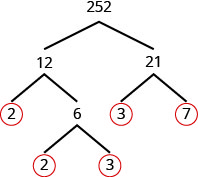
Step 2. Write 252 as the product of all the circled primes. \(252=2\cdot 2\cdot 3\cdot 3\cdot 7\)
Find the prime factorization of 126.
- Answer
-
\(2\cdot 3\cdot 3\cdot 7\)
Find the prime factorization of 294.
- Answer
-
\(2\cdot 3\cdot 7\cdot 7\)
One of the reasons we look at multiples and primes is to use these techniques to find the least common multiple of two numbers. This will be useful when we add and subtract fractions with different denominators. Two methods are used most often to find the least common multiple and we will look at both of them.
The first method is the Listing Multiples Method. To find the least common multiple of 12 and 18, we list the first few multiples of 12 and 18:
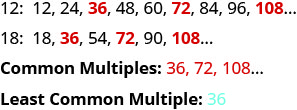
Notice that some numbers appear in both lists. They are the common multiples of 12 and 18.
We see that the first few common multiples of 12 and 18 are 36, 72, and 108. Since 36 is the smallest of the common multiples, we call it the least common multiple. We often use the abbreviation LCM.
The least common multiple (LCM) of two numbers is the smallest number that is a multiple of both numbers.
The procedure box lists the steps to take to find the LCM using the prime factors method we used above for 12 and 18.
- List several multiples of each number.
- Look for the smallest number that appears on both lists.
- This number is the LCM.
Find the least common multiple of 15 and 20 by listing multiples.
- Answer
-
Make lists of the first few multiples of 15 and of 20, and use them to find the least common multiple. 
Look for the smallest number that appears in both lists. The first number to appear on both lists is 60, so 60 is the least common multiple of 15 and 20. Notice that 120 is in both lists, too. It is a common multiple, but it is not the least common multiple.
Find the least common multiple by listing multiples: 9 and 12.
- Answer
-
\(36\)
Find the least common multiple by listing multiples: 18 and 24.
- Answer
-
\(72\)
Our second method to find the least common multiple of two numbers is to use The Prime Factors Method. Let’s find the LCM of 12 and 18 again, this time using their prime factors.
Find the Least Common Multiple (LCM) of 12 and 18 using the prime factors method.
- Answer
-




Notice that the prime factors of \(12(2\cdot 2\cdot 3)\) and the prime factors of \(18(2\cdot 3\cdot 3)\) are included in the LCM \((2\cdot 2\cdot 3\cdot 3)\). So 36 is the least common multiple of 12 and 18.
By matching up the common primes, each common prime factor is used only once. This way you are sure that 36 is the least common multiple.
Find the LCM using the prime factors method: 9 and 12.
- Answer
-
\(36\)
Find the LCM using the prime factors method: 18 and 24.
- Answer
-
\(72\)
- Write each number as a product of primes.
- List the primes of each number. Match primes vertically when possible.
- Bring down the columns.
- Multiply the factors.
Find the Least Common Multiple (LCM) of 24 and 36 using the prime factors method.
- Answer
-
Find the primes of 24 and 36.
Match primes vertically when possible.
Bring down all columns.
Multiply the factors. 
The LCM of 24 and 36 is 72.
Find the LCM using the prime factors method: 21 and 28.
- Answer
-
\(84\)
Find the LCM using the prime factors method: 24 and 32.
- Answer
-
\(96\)
Access this online resource for additional instruction and practice with using whole numbers. You will need to enable Java in your web browser to use the application.
Key Concepts
- Place Value as in Figure.
- Name a Whole Number in Words
- Start at the left and name the number in each period, followed by the period name.
- Put commas in the number to separate the periods.
- Do not name the ones period.
- Write a Whole Number Using Digits
- Identify the words that indicate periods. (Remember the ones period is never named.)
- Draw 3 blanks to indicate the number of places needed in each period. Separate the periods by commas.
- Name the number in each period and place the digits in the correct place value position.
- Round Whole Numbers
- Locate the given place value and mark it with an arrow. All digits to the left of the arrow do not change.
- Underline the digit to the right of the given place value.
- Is this digit greater than or equal to 5?
- Yes—add 1 to the digit in the given place value.
- No—do not change the digit in the given place value.
- Replace all digits to the right of the given place value with zeros.
- Divisibility Tests: A number is divisible by:
- 2 if the last digit is 0, 2, 4, 6, or 8.
- 3 if the sum of the digits is divisible by 3.
- 5 if the last digit is 5 or 0.
- 6 if it is divisible by both 2 and 3.
- 10 if it ends with 0.
- Find the Prime Factorization of a Composite Number
- Find two factors whose product is the given number, and use these numbers to create two branches.
- If a factor is prime, that branch is complete. Circle the prime, like a bud on the tree.
- If a factor is not prime, write it as the product of two factors and continue the process.
- Write the composite number as the product of all the circled primes.
- Find the Least Common Multiple by Listing Multiples
- List several multiples of each number.
- Look for the smallest number that appears on both lists.
- This number is the LCM.
- Find the Least Common Multiple Using the Prime Factors Method
- Write each number as a product of primes.
- List the primes of each number. Match primes vertically when possible.
- Bring down the columns.
- Multiply the factors.
Glossary
- composite number
- A composite number is a counting number that is not prime. A composite number has factors other than 1 and itself.
- counting numbers
- The counting numbers are the numbers 1, 2, 3, …
- divisible by a number
- If a number \(m\) is a multiple of \(n\), then \(m\) is divisible by \(n\). (If 6 is a multiple of 3, then 6 is divisible by 3.)
- factors
- If \(a\cdot b=m\), then \(a\) and \(b\) are factors of \(m\). Since \(3 \cdot 4 = 12\), then 3 and 4 are factors of 12.
- least common multiple
- The least common multiple of two numbers is the smallest number that is a multiple of both numbers.
- multiple of a number
- A number is a multiple of \(n\) if it is the product of a counting number and \(n\).
- number line
- A number line is used to visualize numbers. The numbers on the number line get larger as they go from left to right, and smaller as they go from right to left.
- origin
- The origin is the point labeled 0 on a number line.
- prime factorization
- The prime factorization of a number is the product of prime numbers that equals the number.
- prime number
- A prime number is a counting number greater than 1, whose only factors are 1 and itself.
- whole numbers
- The whole numbers are the numbers 0, 1, 2, 3, ....


